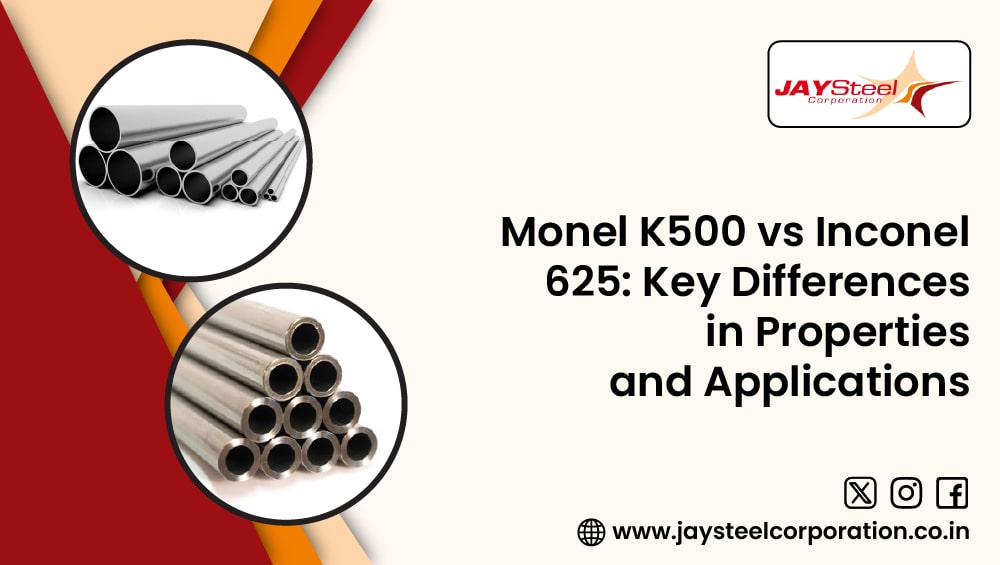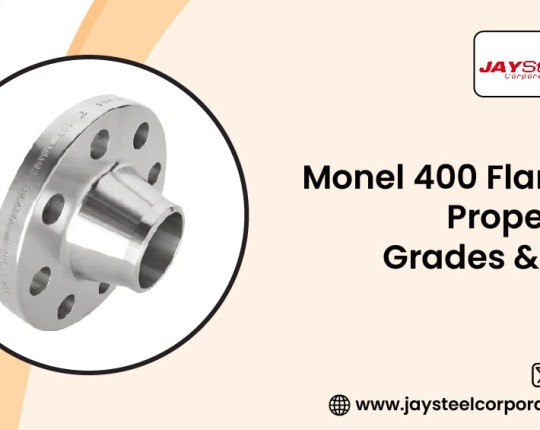We understand completely. Here we have come up with the high-performance alloys for demanding industrial environments; Monel K500 and Inconel 625 will be the most reliable names for your applications. These alloys are largely known for their notable power and corrosion resistance. Jay Steel Corporation, an ISO 2015, ISO 2018-certified company, provides pressure equipment instructions (EU), and we meet high-quality Monel K500 and Inconel 625 products ASTM, DIN, BS, ASME and ANSI standards.
In this blog, we’ll dive into the key nuances in Monel K500 aspects and Inconel 625 factors, their respective applications, and contextual standards such as UNS and ASTM.
Monel K500 & Inconel 625: Understand It Neatly
Although their composition and ideals can vary greatly, it is not strange that both Monel K500 and Inconel 625 are nickel-reliant alloys.
Monel K500 is a nickel-copper alloy that gives a good effect because of the addition of aluminium and titanium.
Inconel 625 is a nickel-chromium-molybdenum alloy known for its outstanding corrosion resistance and high cost.
UNS Designations: What They Mean
- Monel K500: UNS N05500
- Inconel 625: UNS N06625
These UNS designations are critical for identifying the chemical makeup and ensuring you obtain the right alloy for your application, specifically for global trade and industrial submission.
ASTM Standards for Monel K500 and Inconel 625
- Monel K500: ASTM B865
- Inconel 625: ASTM B443
Adhering to these ASTM standards guarantees predictable quality, traceability, and performance. Every product correctly complies with these and different national and international standards like BS, DIN, and ASME.
Monel K500 Aspects: Asset Meets Corrosion Resistance
Monel K500 combines the corrosion resistance of Monel 400 with higher strength due to heat treatment.
Key Monel K500 Aspects Mix:
- Composition: There is about 65% nickel and 28-34% copper, with trace components of iron, manganese, aluminum, and titanium.
- Corrosion Resistance: There is the best chemical environment with amazing resistance to seawater and saltwater.
- Mechanical Properties: Tensile strength is very high, and yet yield strength was also good (up to 120 KSI tensile capacity after heat treatment).
- Hardness: The thing that makes them become hardened via heat treatment, making it ideal for high-strength applications.
- Temperature Range: Both have the capability to withstand temperatures up to 400°C.
Inconel 625 Components: The High-Performance Workhorse
Inconel 625 is well-known for its unusual resistance to oxidation, corrosion, and extreme temperatures.
Key Inconel 625 Elements Mix:
- Composition: 58% nickel, 20-23% chromium, and 8-10% molybdenum; the traces of iron, niobium, and titanium make this alloy unique and performable at any stage.
- Corrosion Resistance: The resistance to pitting, crevice corrosion, and stress corrosion cracking, notably in marine as well as chemical environments.
- Mechanical Resource: Tensile strength, which is up to 120 KSI and creep resistance at boosted temperatures, which is very high and generally occurs in the manufacturing activity.
- Temperature Range: Ideal for high-temperature applications, it is stable and can handle 980°C.
- Weldability: Fantastic, confessing fabrication into complicated components.
Monel K500 vs Inconel 625: Applications Compared
Monel K500 Applications:
- Marine hardware and seawater valves
- Oil and gas industry components
- Aerospace parts requiring high strength and corrosion resistance
- Pump shafts and impellers
- Nuclear reactors and chemical processing equipment
Inconel 625 Applications:
- Aerospace engines and gas turbines
- Chemical processing vessels
- Heat exchangers and exhaust systems
- Nuclear reactors and marine applications
- High-temperature industrial furnaces
Both alloys shine in corrosive and demanding environments, though Inconel 625 excels in extraordinary temperatures and so corrosive chemical applications, while Monel K500 is treasured where a balance of high asset and corrosion resistance at moderate temperatures is needed.
Why Go with Jay Steel Corporation for Your Alloy Needs?
We are committed to quality and observance. We offer:
- Certified Quality: ISO 2015, ISO 2018, PED (EU), and FIEO certifications, which we can certify the quality of.
- Standards observance: Our Monel K500 & Inconel 625 products meet ASTM B865 and ASTM B443, respectively, as well as international standards.
- Customization: We can customized sizes according to your needs and finishes to suit your industrial boundaries.
- Veteran discussion: Gather a free deliberation from our alloy specialists to find the proper solution for your project.
How to Choose Between Monel K500 and Inconel 625?
When choosing between Monel K500 and Inconel 625, consider:
- Operating setting: For intolerable heat and extremely corrosive chemicals, Inconel 625 is preferred.
- Mechanical asset needs: Monel K500 offers superb properties, predominantly after heat treatment.
- Cost issues: Inconel 625 typically costs more due to its alloying elements and processing.
- Fabrication obstacles: Both alloys have supportive weldability; however, they differ barely in machining characteristics.
Let’s Summarize: Monel K500 vs Inconel 625 – Which Will Be Best For You?
As we discussed, both Monel K500 & Inconel 625 offer the best performance in their different applications. Many times, for robust corrosion resistance intertwined with high properties at moderate temperatures, Monel K500 is your go-to alloy. For applications demanding intense temperature tolerance and the best corrosion resistance, Inconel 625 stands out alone as the best.
At Jay Steel Corporations, we validate that you receive the exact alloy product with the certifications and quality you await—defended by global standards like ASTM, UNS, and PED. Contact us today for a free consultation and let our expert consultants guide you to the correct alloy solution for your industrial needs.



